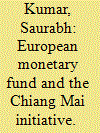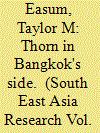| Srl | Item |
| 1 |
ID:
122806


|
|
|
| 2 |
ID:
106880


|
|
|
|
|
| Publication |
2011.
|
| Summary/Abstract |
Recent political events, such as the coup of 2006 or the 'Red Shirt' uprisings of 2010 underlined the divisions in Thai society between the provinces and the capital. As one of the world's most primate cities, Bangkok exerts a tremendous political, economic and cultural force upon the rest of Thailand. But how is such pressure interpreted, internalised and/or subverted? In this article, I look at Thailand's second-largest city, Chiang Mai, in Thailand's North, and the struggle to cure an increasing sense of urban crisis and thereby assert the former independent capital's symbolic authority vis-à-vis Bangkok. I examine this by looking at two specific discourses: that of architecture and spirit mediumship. Northern Thai architects attempt to cure Chiang Mai's ills through recourse to the 'cultural heritage' of the city's urban space, while spirit mediums call upon the sacred power of that space in order to restore Chiang Mai's 'lost' prosperity. The focal point for each effort lies at the city's centre: the Three Kings Monument and its surrounding plaza (khuang). Here, each group casts themselves as those most able to put Chiang Mai's past in physical form and thereby ensure Chiang Mai's future. In this article, I examine how ideas of cultural heritage become entwined with magico-religious concepts of power (sak). In each, there is a search for efficacious power in the face of political and cultural domination from Bangkok.
|
|
|
|
|
|
|
|
|
|
|
|
|
|
|
|
| 3 |
ID:
190146


|
|
|
|
|
| Summary/Abstract |
This paper explores neighbourhood-based projects such as “local project” (Magnaghi, 2005), the strategic scenarios that set out a process of mobilisation and promotion of local resources, planned and run by local people. It focuses on two residential communities in Wua-Lai neighbourhood, namely Chumchon Wat Muen-Sarn and Chumchon Wat Sri-Suphan. The analysis deals with three local projects: Wua-Lai Walking Street and Saturday Market, Lanna Arts Study Centre and community museums. It seeks to understand how the residents use silver handicraft, Buddhist temple and local marketplaces for shaping their projects and for connecting the neighbourhood to the city. This study allows us to identify the key elements in place on which the local projects are premised and how these elements reproduce sense of belonging and sociability that create the potential for collective action. It intends to highlight on the neighbourhood capacities, and its limits, to carry out local initiatives and to challenge more economic forces.
|
|
|
|
|
|
|
|
|
|
|
|
|
|
|
|
| 4 |
ID:
122905


|
|
|
|
|
| Publication |
2013.
|
| Summary/Abstract |
Scholarship on the integration of Siam's northern periphery has largely overlooked the role of sacred space in the transition to modernity. While Lanna had been politically and economically integrated into modern Siam, sacred space remained a contested point of articulation between local elites and Bangkok officials long into the twentieth century. Khruba Sriwichai's movement to restore sacred spaces throughout the region shows not only how resistance to Siam continued well after the political-economic integration of the region, but also how this resistance drew on the legacy of sacro-spatial legitimacy, once a crucial part of the pre-modern Chiang Mai state.
|
|
|
|
|
|
|
|
|
|
|
|
|
|
|
|